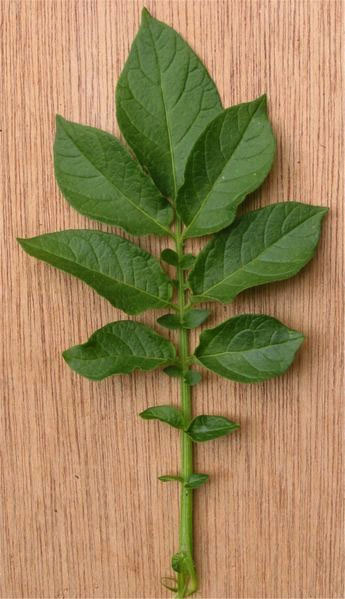 Leaf of S. tuberosum: photograph reproduced from Wikipedia |
 Flowers of S. tuberosum: image from Wikipedia |
 Potato variation: image by Agricultural Research Service of United States Department of Agriculture reproduced from Wikipedia |
 From Engler & Prantl's Die Natürlichen Pflanzenfamilien IV 3b f. 10 p.p. (1897). |
 Line drawing by M. Szent Ivany . |
 Illustration by an unknown artist [W.G.S. 1906] from Botanical J. Linn.Soc. 38 (1909), pl. 45. |
 Detail of flowers from Botanical J. Linn.Soc. 38 (1909), pl. 45. |
 Distribution map generated from Australia's Virtual Herbarium. |

Synonymy
Solanum tuberosum L., Sp. Pl. 1: 185 (1753)
T: “Habitat in Peru”; lecto: Herb. LINN 248.12 (microfiche AD) fide Hawkes in Proc. Linn. Soc. London 166 : 106 (1956). See the Linnaean Plant Name Typification Project.
Description
A sprawling perennial herb to 50 cm, regenerating each year from underground tubers (the only species of Solanum in
Leaves often large, ovate-oval in outline, pinnate with 5–9 leaflets; petiole and leaf rhachis angular in section, sometimes narrowly winged above; petiolules present, also winged; leaflets ovate, the lower ones rounded or acute, the upper ones acuminate, much smaller interstitial leaflets often present along the leaf rhachis.
Inflorescence a leaf-opposed cymose panicle of few to 8 flowers; peduncle 5–10 cm long; pedicels 1–2 cm long, with an articulation shortly below the calyx. Calyx tube c. 5 mm long, calyx lobes 5–8 mm long, lanceolate, acuminate. Corolla subrotate to rotate-pentagonal, white or pale violet. Anthers 5–7 mm long, cordate below, oblong; filaments c. 2 mm long, short and thick. Style 8–9 mm long.
Fruit 1.5–2 cm diam., globular, greenish, often sparsely produced in cultivation. n = 24.
Distribution and ecology
Native to South America, the potato, Solanum tuberosum, is not known to be naturalised in Australia but frequently persists for some time about domestic refuse heaps, in fields that have been cropped, or on roadsides where potatoes have been dropped.
Widely cultivated in temperate areas - see the Solanaceae Source site for an account.
Common name
Potato
Relationships
A member of subg. Potatoe, species of which are usually creepers or vines with deeply lobed leaves and lacking spines or stellate hairs. American in origin.
Other species of this group in
Notes
Solanum tuberosum is a crop of major importance in the temperate areas of the world and in the uplands of the
No attempt will be made here to cover the tremendous amount of literature, both agronomic and taxonomic, published on this species. An introduction to the taxonomy of the section will be found in the major works. D.S. Correll, The Potato & its wild relatives, Texas Research Foundation (1962); C.M. Ochoa, The Potatoes of South America: Bolivia, C.U.P. (1990), J.G. Hawkes, The Potato Evolution, Biodiversity and genetic Resources, Belhaven Press, London (1990).
Selected specimens
S.A.: lower Coorong roadside, D.E. Symon 10447 (AD).
From the web
A line drawing of S. tuberosum can be downloaded from www.anbg.gov.au/poison-plants/poison-PDFs/Solanum-tuberosum.pdf
Images of the plant with flowers and potato tuber (not the fruit) can be seen at the Plants of Hawaii site.
There are some high resolution images of this species at http://www.plantsystematics.org/
The United States Department of Agriculture Germplasm Resources Information Network (GRIN) has numerous links for this species.
Further information and links for this species can be found on the Solanaceae Source site.